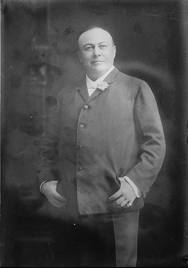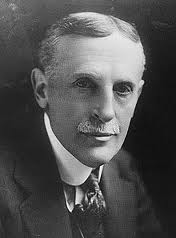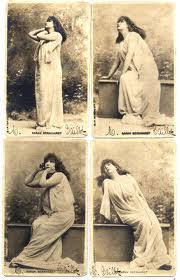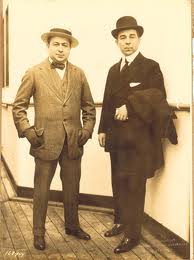Before the Broadway long run, before George M. Cohan created the Broadway of myth and legend and long before hit musicals such as Phantom, Chicago and Matilda brought droves of people into New York much of America’s professional theatre was composed of road companies. The theatre travelled to America and it went to every corner of the continent. This is in the mid- to late-19th century when an actor/manager would put together a company and tour using the country’s transcontinental railroads, playing for weeks in Chicago and San Francisco and then one night on stands in between in towns like Butte, Montana and Sioux Falls, South Dakota. But then along came the Theatrical Syndicate, which was often referred to as simply “The Syndicate.” It was composed of six men and they would change the U.S. stage forever.
Klaw and Erlanger
Marc Klaw and A.L. Erlanger were instrumental in creating the Theatrical Syndicate. Klaw, who was a lawyer from Kentucky and Erlanger, who was a theatre producer and owner from Buffalo, NY, were business partners before the Syndicate was ever created. In 1886, the duo created a booking agency that secured tours and theatres for companies going on the road. They were hugely successful and along with running the agency they built and bought theatres and vaudeville houses throughout the U.S. In 1896, Klaw and Erlanger teamed up with four other theatre owners to create the Syndicate.
The Meeting
The Theatrical Syndicate’s beginnings can be traced to a lunch at the Holland House in New York City. Along with Klaw and Erlanger, those in attendance included Charles Frohman, Al Hayman, Samuel Nixon and Fred Zimmerman. Together these six men owned a vast amount of theatrical real estate across America. Within weeks after the meeting the men joined forces to use their holding and create a chain of theatres that stretched from coast to coast.
The idea was to create a chain that would make it easy for companies to book touring routes and venues that would be profitable. The Syndicate would get rid of the manager because they would manage everything. And they did. Along with efficiency, the group also engaged in monopolistic business practices such as prohibiting theatre companies from booking any theatres not owned by them. Also, if a company didn’t turn a profit one year, then chances were very good that they would not be on the Syndicate’s list of touring companies the following year.
Reactions
Although many important theatre professionals fought the Syndicate, such as Sarah Bernhardt,James O’Neill, Francis Wilson, James A. Herne and Richard Mansfield, many eventually had to give in. One of America’s preeminent stage actresses, Minnie Maddern Fiske, was famous for two things: great interpretations of roles written by Ibsen, Shaw and Wilde and he fight against the Syndicate, which lead to her travelling the country and playing in tents. Her husband, Harrison Grey Fiske, who owned the Dramatic Mirror, the leading theatrical publication of its time, mounted a fierce editorial battle against the Syndicate, painting them a villains and devils.
The Brothers Shubert
Although the Theatrical Syndicate thrived for close to a decade, there was continued resistance from various segments of the theatrical community. The Shubert brothers, who can to New York City from upstate New York, slowly created their own chain of theatres. They even joined forces very briefly with the Syndicate.
But the Shuberts amassed enough theatres to be independent of the Syndicate and competed directly with them. They created a publicity campaign that included the great Sarah Bernhardt, considered to be one of America’s greatest actresses, touring across the country in second-class houses and in tents because the Syndicate would not allow her to perform. The Shuberts also welcomed actors and companies that did not want to book exclusively with them and they often produced works of a similar nature to those being handled by the Syndicate, but the Shuberts made sure their offering had higher production values.
The Syndicate Crumbles
Eventually the Syndicate crumbled. During 1908 and 1909, the organization didn’t have enough productions to fill its theatres and in 1910 leading actors started to defect to the Shuberts. Also in 1910, the National Theatre Owners Association was created as more than 1,200 independent venues across the U.S. joined forces, helping to weaken the Syndicate even more. The Syndicate’s theatrical monopoly was broken. Now it was time for the Shuberts to establish theirs.




